Lions are one of the largest in the cat family – second only to the Tiger. Most wild lions live in Africa with a smaller percentage found in the Gir national park in the Indian state of Gurajat. We will focus on the ” king of the jungle” and leave out Mountain lions (puma, cougar or panther) in the discussion because they are smaller and more related to the Leopard. The lion whose Latin name is panthera is formally divided into two subspecies namely the African lion also known as panthera Leo and the Asiatic lion also known as panthera Leo Persica.
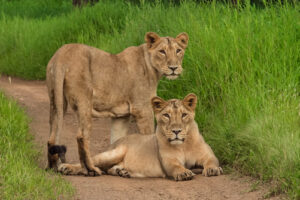 The African lion larger in size when compared to the Asiatic lion. Irrespective of the difference in size between the African and Asiatic lions, they have identical characteristics. They are in general muscular and broad chested cats with hairy tufts at the end of their tails. The adult male lions are in most cases physically larger than the female lioness. Male lions can measure about 2.5m long without their tails and 3.5m long inclusive of their tails. Additionally, male lions do weigh about 275kgs in comparison to the lionesses that weighs between 110kgs to 168kgs. It is very important for the lions to weigh this much because it helps them when hunting much bigger animals like the giraffes, elephants, buffaloes among others. Science has it that the female lions have a much longer life span of up to 18 years in comparison to the males who live up to 16 years
The African lion larger in size when compared to the Asiatic lion. Irrespective of the difference in size between the African and Asiatic lions, they have identical characteristics. They are in general muscular and broad chested cats with hairy tufts at the end of their tails. The adult male lions are in most cases physically larger than the female lioness. Male lions can measure about 2.5m long without their tails and 3.5m long inclusive of their tails. Additionally, male lions do weigh about 275kgs in comparison to the lionesses that weighs between 110kgs to 168kgs. It is very important for the lions to weigh this much because it helps them when hunting much bigger animals like the giraffes, elephants, buffaloes among others. Science has it that the female lions have a much longer life span of up to 18 years in comparison to the males who live up to 16 years
Interesting Facts About Lions
Lions are Found in Africa and Asia: In Africa, large cats and lions in particular can be viewed in several national parks and game reserves throughout the sub Saharan Africa. Most of these parks are famous for having unique lions ranging from maneless, black-maned, man-eaters, tree climbing lions among others. The Duba plains of Botswana in the northern reaches of the Karango delta is home to the 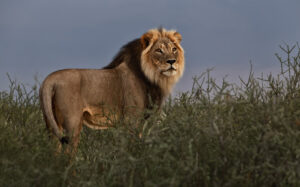 biggest sized lions in all over Africa. These lions are quite unique in such a way that they have adapted to hunting during daytime as opposed to the fact that lions largely hunt in the night. The Kruger national park in South Africa is another destination for viewing the African lion. The Kgalagadi transfrontiers park in the Kalahari Desert is home to the black maned lions. Tanzania’s Selous Game Reserve is also home to Africa’s maneless lions. These maneless lions of the Selous Game Reserve are actually the dominant males of the pride. Kenya’s Tsavo national park is known for the legendary man-eating lions. One could be wondering why they are called the man-eaters. Well, in the year 1898, during the construction of the Kenya/Uganda railway line, the construction workers were attacked by man-eating lions. These lions killed up to 130 men making it one of the greatest challenges met during the construction of the railway line. The blood thirsty lions were eventually shot and killed after which they were sold to the field museum of natural history in Chicago. These infamous man-eating lions of Tsavo are still on display at the museum to this day. Tourists love visiting the vast Tsavo National park with the sole intention of encountering the descendants of the original man eater lions.
biggest sized lions in all over Africa. These lions are quite unique in such a way that they have adapted to hunting during daytime as opposed to the fact that lions largely hunt in the night. The Kruger national park in South Africa is another destination for viewing the African lion. The Kgalagadi transfrontiers park in the Kalahari Desert is home to the black maned lions. Tanzania’s Selous Game Reserve is also home to Africa’s maneless lions. These maneless lions of the Selous Game Reserve are actually the dominant males of the pride. Kenya’s Tsavo national park is known for the legendary man-eating lions. One could be wondering why they are called the man-eaters. Well, in the year 1898, during the construction of the Kenya/Uganda railway line, the construction workers were attacked by man-eating lions. These lions killed up to 130 men making it one of the greatest challenges met during the construction of the railway line. The blood thirsty lions were eventually shot and killed after which they were sold to the field museum of natural history in Chicago. These infamous man-eating lions of Tsavo are still on display at the museum to this day. Tourists love visiting the vast Tsavo National park with the sole intention of encountering the descendants of the original man eater lions.
Lions can also be viewed at Tanzania’s Serengeti national park and Kenya’s Masai Mara national park. Uganda is also a major destination for viewing African lions. In Uganda, lions can be viewed from Murchison falls national park, Kidepo valley national park and the Queen Elizabeth national park. The Kidepo valley national park hosts about 132 individual lions while the Murchison falls national park is 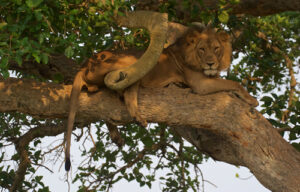 famous for hosting lions that are only active very early in the morning (just before sunrise) and then in the late evening when the sun is setting. Queen Elizabeth national park is the third destination in Uganda for viewing lions. The park hosts the largest population of lions – about 250 of them. Ever heard of the tree climbing lions? Well, Queen Elizabeth national park is famous for its tree climbing lions at the Ishasha plains. One can see the lions of Queen Elizabeth National Park while on a standard game drive or by registering for the special lion tracking experience with Researchers. While on a game drive, you cannot miss out on viewing the beautiful Rwenzori mountains in the horizon and the lions having the best of their time lazily resting on tree branches.
famous for hosting lions that are only active very early in the morning (just before sunrise) and then in the late evening when the sun is setting. Queen Elizabeth national park is the third destination in Uganda for viewing lions. The park hosts the largest population of lions – about 250 of them. Ever heard of the tree climbing lions? Well, Queen Elizabeth national park is famous for its tree climbing lions at the Ishasha plains. One can see the lions of Queen Elizabeth National Park while on a standard game drive or by registering for the special lion tracking experience with Researchers. While on a game drive, you cannot miss out on viewing the beautiful Rwenzori mountains in the horizon and the lions having the best of their time lazily resting on tree branches.
Lions are Brave, Strong willed and Natural Leaders: A male lion is a natural born leader who all the others in the pride follow. Lions are also very strong willed and determined to the extent that they 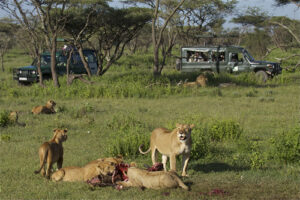 can go as far as hunting animals that are way bigger than them. Apart from smaller antelopes or warthogs, lions can take down buffaloes and giraffes if they want to. The lion is not easily intimidated or defeated in a duel with other savanna predators. The lion also represents power and courage. This can be seen in the way with which it defends the pride and their territories. No wonder several communities and individuals use a lion as their emblem and source of inspiration on different fronts. The lion is also extremely confident and a risk taker. This quality has given it an advantage over other predators in the savanna.
can go as far as hunting animals that are way bigger than them. Apart from smaller antelopes or warthogs, lions can take down buffaloes and giraffes if they want to. The lion is not easily intimidated or defeated in a duel with other savanna predators. The lion also represents power and courage. This can be seen in the way with which it defends the pride and their territories. No wonder several communities and individuals use a lion as their emblem and source of inspiration on different fronts. The lion is also extremely confident and a risk taker. This quality has given it an advantage over other predators in the savanna.
Lions Live in Prides: Lions are the only big cats that live in groups called prides. These prides often consist of up to 30 Lions, lionesses and cubs inclusive. The prides are headed by the dominant male or a 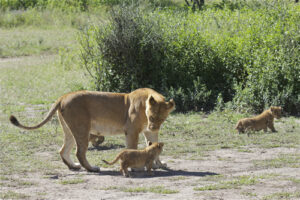 coalition of males. The size of the pride largely depends on the amount of food available in the area. Did you know that lions do not mate with their relatives? Well, when Lions make 2-4 years of age, they are considered to be adults. The young male lions will be bullied out of the pride by the dominant male or decide on their own to leave the pride in order to start a new life. The young lion or coalition will keep wandering about the savanna until they are mature enough to challenge the dominant male of a new pride. If they successfully take over from a particular dominant male, they become the new head of the pride. They will kill all cubs of the defeated male and mate with the lionesses of the new pride hence multiplying their own genes.
coalition of males. The size of the pride largely depends on the amount of food available in the area. Did you know that lions do not mate with their relatives? Well, when Lions make 2-4 years of age, they are considered to be adults. The young male lions will be bullied out of the pride by the dominant male or decide on their own to leave the pride in order to start a new life. The young lion or coalition will keep wandering about the savanna until they are mature enough to challenge the dominant male of a new pride. If they successfully take over from a particular dominant male, they become the new head of the pride. They will kill all cubs of the defeated male and mate with the lionesses of the new pride hence multiplying their own genes.
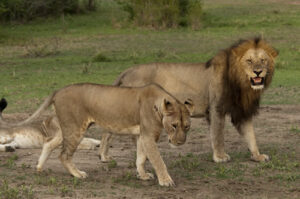 Lions are Social: Lions are very social big cats and will take care of their cubs together. Their cubs are free to suckle from any lioness in the pride that has milk. When lions hunt, they often leave their young with a caretaker lioness. Lion Cubs are born with spots which tend to disappear as they grow older. These spots help to camouflage them in the wild, protecting them from hyenas, cheetahs, Leopards and even buffaloes. Lions are the only big cats that roar together. Male lions may make separate roars to mark their territories. The roar of a male lion is so loud that it can be heard from 8 miles away.
Lions are Social: Lions are very social big cats and will take care of their cubs together. Their cubs are free to suckle from any lioness in the pride that has milk. When lions hunt, they often leave their young with a caretaker lioness. Lion Cubs are born with spots which tend to disappear as they grow older. These spots help to camouflage them in the wild, protecting them from hyenas, cheetahs, Leopards and even buffaloes. Lions are the only big cats that roar together. Male lions may make separate roars to mark their territories. The roar of a male lion is so loud that it can be heard from 8 miles away.

